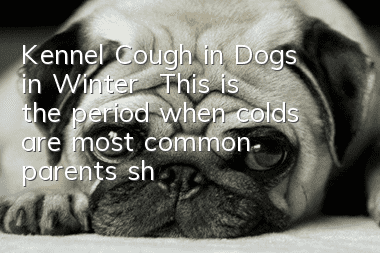Kennel Cough in Dogs in Winter | This is the period when colds are most common, parents should take precautions!

In winter, the temperature difference between air conditioners inside and outside the house is particularly likely to cause many canine infectious diseases, among which kennel cough also enters a peak period at this time. Kennel cough, also known as canine infectious tracheobronchitis, is a canine infectious respiratory disease caused by a variety of pathogens and can affect dogs of any age. As long as one dog has this symptom, other dogs that come into contact with it will also have this symptom.
1. What is kennel cough
The official name of "kennel cough" in veterinary medicine is canine infectious tracheobronchitis. Because of its rapid contagion and contagious nature, few healthy dogs (including all dogs that have not been immunized) who have been exposed to sick dogs are spared, and often all the dogs in a household or all the puppies in the litter are sick, so It's called "kennel cough." The course of the disease is more than a week, and in a few cases it can last for several months. Most dogs can gradually recover as their body's resistance improves, but a few dogs will develop bronchopneumonia due to lack of timely treatment.
2. Causes of the disease
Because the pathogenic microorganisms of concurrent or secondary infections are different, the symptoms vary in severity. The symptom is characterized by vibrating, severe, persistent spasmodic cough. "Kennel cough" has a long course and is not easy to cure, so some people call it "canine intractable cough."
The main cause of "kennel cough" is Bordetella bronchiseptica in dogs. The main symptom of "kennel cough" is a characteristic long-lasting cavity cough, similar to whooping cough in children, and at the end of the cough, there is a painful lowering movement of "sputum clicking" and a long "clicking" sound. There are no complications. The body temperature of sick dogs with this disease is generally normal, and their appetite is not affected. The course of the disease is long, and commonly used antibiotic treatments are less effective. Young and young sick dogs with concurrent or secondary canine parainfluenza virus and adenovirus type 2 infections may also suffer from burps. Symptoms such as sneezing, runny nose, diarrhea and vomiting, poor general condition, and doubtful or poor prognosis.
3. Symptoms
In the early stage of the disease, the dog's symptoms include dry cough, and occasional vomiting or nausea after coughing, but the spirit and appetite are normal, generally there is no fever, and there are no symptoms such as nasal discharge. Within a few days, his symptoms included painful cough, elevated body temperature, loss of appetite, and purulent nasal discharge. The treatment of kennel cough requires treating both the symptoms and the symptoms. On the one hand, symptoms such as coughing must be controlled, and on the other hand, the pathogens must be killed. It should be noted that because kennel cough is often induced by a variety of pathogenic bacteria, it is difficult for general drugs to reach this site, and most antibiotics cannot have an immediate therapeutic effect. some dogsThe owner therefore used large doses of antibiotics. However, this approach is very unscientific. High doses of antibiotics for a long time will destroy the immune barrier of the dog's body and create opportunities for virus invasion.
In the early stage, if this situation is found, the dog can be fed some antiviral oral liquid, such as Shuanghuanglian oral liquid plus Shedan Chuanbei liquid, etc., and then injected with dexamethasone. Also pay attention to keeping your dog warm from the cold. In addition, don’t forget to disinfect your home regularly to give your dog a clean environment! Diagnosis and Treatment Methods for Dog Cough Cough is a symptom caused by a variety of diseases. It is not an independent disease name. It is a protective reflex action that can Foreign bodies or secretions from the respiratory tract are expelled from the body.
But excessive coughing is a pathological state, which often affects food intake and rest, causes weight loss, and secondary emphysema and other diseases. There are many diseases with cough symptoms, such as canine distemper, canine infectious tracheobronchitis, canine parainfluenza, canine herpes virus disease, canine tuberculosis, etc.; parasitic diseases such as filariasis; common diseases such as Pulmonary edema, lobar pneumonia, bronchopneumonia, tracheitis, bronchitis, tracheal paralysis, laryngitis and colds can all cause cough.
IV. Various viral diseases that cause cough
Cough caused by canine distemper also has a biphasic fever type, with increased eye secretions, yellow urine, pustular rash on the inner thighs of the abdomen, rhinitis, acute catarrhal inflammation of the digestive tract and respiratory mucosa, and a dry cough in the early stage. , later developed into wet cough, and later neurological symptoms;
Canine infectious tracheobronchitis is also known as kennel cough. A single mild case of canine symptoms is a dry cough, followed by vomiting. The cough is often aggravated with exercise or temperature changes. Artificial cough induction is positive. When secretions block part of the respiratory tract Sometimes, symptoms include depression, loss of appetite, purulent nasal discharge, painful cough, and persistent retching or vomiting after a long time;
Canine parainfluenza often develops suddenly, with body temperature rising, serous fluid or even purulent nasal fluid, and sick dogs coughing violently, losing appetite, and feeling lethargic. A few can cause hindquarter paralysis and hemorrhagic enteritis symptoms;
Canine herpes virus disease mostly occurs in puppies less than 3 weeks old. Dogs aged 2 to 3 weeks old will have symptoms of upper respiratory tract infection such as loss of appetite, salivation, diarrhea, runny nose, sneezing, dry cough, etc. The body temperature is not high. Female dogs Causes miscarriage, vaginitis, and blister-like lesions on the vaginal mucosa;
The main symptoms of canine tuberculosis are fever, gradual weight loss, long-term stubborn cough, and rales in the lungs. Parasitic diseases are mainly caused by canine heartworm disease and Strongyloides. In the early stage of heartworm disease, fatigue, weight loss, and coughing after exercise occur. In the final stage, dogs with heartworm disease are prone to sudden death due to heartworm obstruction in the right ventricle and pulmonary artery;
Strongyloides is susceptible to infecting puppies, with symptoms such as eczematous dermatitis, bronchopneumonia, diarrhea, dehydration, exhaustion, anemia, and cachexia.
Pulmonary edema often manifests as extremeIt is characterized by difficulty breathing and foamy red nasal fluid.
Lobar pneumonia is characterized by persistent high fever, respiratory disturbance, and widespread dullness in the lungs. Bronchopneumonia is clinically characterized by flaccid fever, rapid breathing, scattered focal dullness areas on percussion, and crepitus on auscultation.
Tracheobronchitis is clinically characterized by coughing, wheezing, and rales on chest auscultation. It often attacks acutely in the cold season; tracheal paralysis emits a characteristic "ga" sound when excited, exercising, drinking, eating, stretching the neck, etc. Dry intermittent cough with shouts, cyanosis of mucous membranes. In addition to the symptoms of cough, laryngitis also has symptoms of swelling, heat and pain in the throat. In addition to wet cough, colds can also have symptoms such as depression, loss of appetite, flushing of the conjunctiva, blurry eyes and tears, elevated body temperature, and watery nasal discharge.
- Treating Mastitis in Dogs
- What are the common skin diseases in Alaska? The most important thing is to be careful!
- In order to make your dog drink more water, how to train your dog to drink from a drinking fountain?
- Eight major causes of vomiting in dogs, what you need to know about raising a dog!
- Why do dogs catch colds and how to treat them?
- How to vaccinate German Shepherd
- Why do dogs need blood tests if they have a cold?
- How to train a Siamese to do somersaults? Training Siamese cat techniques!
- How to train a Teddy dog to be obedient? Teddy dog training tips!
- Symptoms and treatment of dog fever



